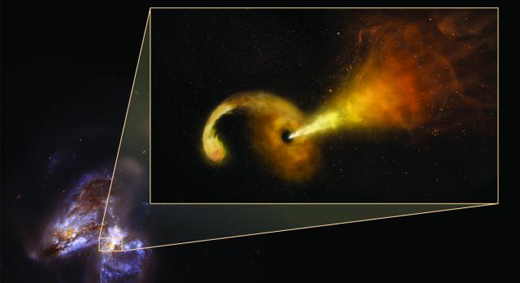Huge black hole is captured ‘eating’ a star for the first time ever
Huge black hole is captured ‘eating’ a star for the first time ever
Mangaloretoday News Network
For the first time ever, stronomers have captured the moment a supermassive black hole 20 million times the size of the Sun ripped apart a star which wandered too close.
Astronomers captured the ‘jet’ of material spurting out of the black hole after the star was devoured, after a ten-year analysis of telescope data.
Inside a pair of colliding galaxies called Arp 299, nearly 150 million light-years from Earth, a black hole 20 million times more massive than the Sun shredded a star more than twice the Sun’s mass.
“Never before have we been able to directly observe the formation and evolution of a jet from one of these events,’ said Miguel Perez-Torres, of the Astrophysical Institute of Andalusia in Granada, Spain.

Astronomers detected a bright burst of infrared emission coming from the nucleus of one of the colliding galaxies in Arp 299 in January 2005.
Continued observations with the VLBA, the European VLBI Network (EVN), and other radio telescopes, carried out over nearly a decade, showed the source of radio emission expanding in one direction, just as expected for a jet.
The measured expansion indicated that the material in the jet moved at an average of one-quarter of the speed of light.
Most galaxies have supermassive black holes, containing millions to billions of times the mass of the Sun, at their cores.
In a black hole, the mass is so concentrated that its gravitational pull is so strong that not even light can escape. When those supermassive black holes are actively drawing in material from their surroundings, that material forms a rotating disk around the black hole, and superfast jets of particles are launched outward.
This is the phenomenon seen in radio galaxies and quasars.
Perez-Torres says, ‘Much of the time, however, supermassive black holes are not actively devouring anything, so they are in a quiet state. Tidal disruption events can provide us with a unique opportunity to advance our understanding of the formation and evolution of jets in the vicinities of these powerful objects.
- Belthangady: Banjarumale records 100% voter turnout in Lok Sabha polls
- Dakshina Kannada, Udupi sees voter turnout of nearly 72%
- Mangaluru International Airport initiates work on precision approach lighting system
- Sandalwood star Rakshit Shetty casts his vote in Udupi, Watch
- Brisk polling across Dakshina Kannada constituency
- Ashta Mutt pontiffs cast vote in Udupi
- Udupi: Candidates Jayaprakash Hegde, Kota Srinivas Poojary exercise franchise
- Vittal: EVM technical glitch delays voting at Karopady booth
- Orange alert: Karnataka State Disaster Management cell gives animated advisory
- Lok Sabha elections 2024: Voting underway in 14 constituencies in Karnataka
- Mangaluru: Activists clash with media, police at Capitanio
- Karnataka Lok Sabha election: Voting timings, Key candidates and phase 2 polling constituencies
- Sullia: Rider dies in bike-jeep collision
- World’s smallest wooden spoon from India sets Guinness World record, Watch
- World Malaria Day 2024: Know theme, significance and prevention tips
- Man hangs from moving car’s door with plastic wrap, video goes viral
- Video of dog twinning with little girl in school uniform is too cute to miss, Watch
- Earth Day 2024: History, theme and 10 activities that can help protect our planet!
- Woman’s Jal Tarang rendition of Aigiri Nandini goes viral, Watch
- World Liver Day 2024: These factors might worsen your liver health
- World Heritage Day 2024: Theme, history, significance, and top 5 heritage sites in India
- How science will get Sun to kiss Ram Lalla’s forehead on Ram Navami
- Artist’s sweet gesture towards waiter impresses the Internet, Watch
- Children addicted to video games, smartphones at risk of Psychosis: Study
- This story of an ailing elephant and her calf will move you to tears
- Listen to your body: 5 types of pain signalling heart issues
- Case Against BJP Leader CT Ravi Over Social Media Post: Karnataka Poll Body
- Lok Sabha polls-24: 63% voter turnout recorded in phase 2
- LS elections 2024: Left rattled by allegations of CPI(M) veteran’s plans to join BJP
- Tejasvi Surya booked for ’seeking votes in the name of religion’ on polling day
- ‘He will shed tears’: Rahul Gandhi’s sharp attack on PM Narendra Modi
- Lok Sabha elections: 4 men collapse and die amid Phase 2 voting in Kerala
- BJP becomes first Indian party to cross Rs 100 crore ad spend on Google
- 78 year old woman, on oxygen support, casts vote in Bengaluru
- Long queues outside Bengaluru hotel for free Benne Dosa, Ghee Laddu on polling day, Watch
- What happens if NOTA gets maximum votes? Supreme Court notice to poll body
- BJP candidate K Sudhakar booked for ’Bribery’ in Karnataka, Rs 4.8 Cr cash seized
- 2 Terrorists dead, 2 army personnel injured as gunbattle resumes in J&K’s Baramulla
- CITY INFORMATION
- TRAVEL
- TOURIST INFORMATION
- HEALTH CARE
- MISCELLANEOUS




 Write Comment
Write Comment E-Mail
E-Mail Facebook
Facebook Twitter
Twitter  Print
Print 

